
ABE Journal
Scope & Guideline
Elevating Discourse in Visual Studies
Introduction
Aims and Scopes
- Interdisciplinary Approaches to Architectural History:
The journal emphasizes the use of interdisciplinary methods, integrating insights from history, sociology, and anthropology to provide a comprehensive understanding of architectural practices. - Focus on Colonial and Post-Colonial Contexts:
A significant portion of the research addresses the impact of colonialism on architecture, examining how colonial powers influenced architectural styles and practices in various regions. - Exploration of Global Architectural Practices:
The journal consistently highlights global perspectives in architectural history, advancing discussions on how different cultures interpret and adapt architectural practices. - Engagement with Modern and Contemporary Issues:
In addition to historical analyses, the journal addresses contemporary architectural challenges, including sustainability, globalization, and the role of architecture in socio-political movements. - Critical Examination of Knowledge Production:
The ABE Journal critiques the processes of knowledge production in architecture, particularly concerning the legacies of imported expertise and the epistemic impositions in architectural education.
Trending and Emerging
- Architectural Responses to Colonial Legacies:
There is an increasing focus on how contemporary architecture addresses and critiques colonial histories, exploring themes of decolonization and the reclamation of architectural narratives. - Interconnections Between Architecture and Climate Change:
Recent articles highlight the relationship between architectural practices and climate change, showcasing innovative solutions and sustainable practices that respond to environmental challenges. - Emotional and Social Dimensions of Architecture:
Emerging research is delving into the emotional and social impacts of architectural spaces, particularly how they shape community interactions and individual experiences. - Pedagogical Innovations in Architectural Education:
A trend toward rethinking architectural education is evident, with discussions surrounding new pedagogies that incorporate diverse perspectives and critical thinking about architectural practices. - Transnational Architectural Histories:
There is a growing interest in transnational narratives that connect architectural histories across borders, emphasizing the global flows of knowledge, materials, and cultural influences.
Declining or Waning
- Traditional Architectural Styles:
Research focusing solely on traditional architectural styles, without contextual or critical examination, has seen a decline as the journal increasingly favors analyses that engage with broader socio-political narratives. - Purely Aesthetic Studies:
There has been a noticeable decrease in studies that concentrate solely on the aesthetic aspects of architecture, as the journal pivots towards exploring the implications of architecture in societal and historical contexts. - Regional Studies with Limited Scope:
Papers that focus narrowly on specific regions without connecting to global or transnational themes are becoming less common, as the journal encourages broader dialogues that transcend local contexts.
Similar Journals

Radovi Instituta za Povijest Umjetnosti-Journal of the Institute of Art History
Connecting Researchers to the Heart of Art Analysis.Radovi Instituta za Povijest Umjetnosti-Journal of the Institute of Art History is a distinguished academic journal dedicated to the exploration and critical analysis of art history, with a special emphasis on the visual arts and performing arts. Published by INST POVIJEST UMJETNOSTI-INST ART HISTORY in Croatia, this journal provides an essential platform for researchers and practitioners to disseminate their findings and engage in scholarly discourse. Since its transition to Open Access in 2008, it has significantly increased the accessibility of its content, fostering a global exchange of ideas. The journal is indexed in notable databases, reflecting its impact within its field, with a current ranking that places it in the Q4 category for History and in Q3 for Visual Arts and Performing Arts. As it spans its converged years from 2015 to 2024, Radovi is poised to expand its influence and continue contributing to the understanding of art historical narratives. Researchers, professionals, and students alike will find this journal a valuable resource for contemporary discussions and theoretical advancements in the study of art.
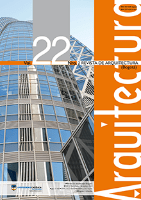
Revista de Arquitectura-Bogota
Shaping the Future of Architecture TogetherRevista de Arquitectura-Bogota is a premier academic journal dedicated to the field of architecture, published by the esteemed Universidad Católica de Colombia, Facultad de Diseño. Since its inception in 1999, this Open Access journal has provided a vital platform for the dissemination of innovative research and critical discourse in architectural studies. With its commitment to the principles of open accessibility, the journal ensures that its diverse range of scholarly articles, case studies, and reviews are readily available to researchers, professionals, and students globally. The journal aims to foster collaboration and dialogue among architects, urban planners, and educators by publishing high-quality content that reflects contemporary issues and advancements in architecture. As an influential resource in the architectural community, Revista de Arquitectura-Bogota plays a crucial role in shaping the future of architectural practice and education in Latin America and beyond.
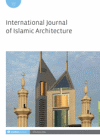
International Journal of Islamic Architecture
Cultivating Interdisciplinary Insights into Islamic DesignThe International Journal of Islamic Architecture, published by INTELLECT LTD in the United Kingdom, is a pivotal scholarly resource dedicated to the exploration of Islamic architecture, design, and cultural expressions within a contemporary framework. With ISSN 2045-5895 and E-ISSN 2045-5909, this journal targets an interdisciplinary audience by bridging the gap between architecture, geography, urban studies, and the arts. Established in 2012, it has swiftly garnered recognition, achieving notable rankings such as Q3 in Architecture and Q2 in Visual Arts and Performing Arts by 2023. Although it currently does not offer open access, its articles are meticulously peer-reviewed, ensuring high academic standards and relevance. Emphasizing the significance of Islamic architectural heritage in global contexts, the journal seeks to foster innovative perspectives and critical discourse, making it an essential platform for researchers, professionals, and students alike to engage with contemporary architectural practices and cultural dialogues.
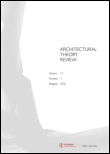
Architectural Theory Review
Advancing Critical Conversations in Architecture.Architectural Theory Review is a prestigious academic journal published by Routledge Journals, Taylor & Francis Ltd, located in the United Kingdom. With a focus on the interdisciplinary field of architecture and its theoretical underpinnings, this journal provides a critical platform for the exploration of contemporary architectural debates. Spanning from 2008 to 2016 and resuming from 2018 to 2024, Architectural Theory Review is categorized in the Q3 quartile of Visual Arts and Performing Arts, reflecting its significant contribution to the discourse within this area, as evidenced by its Scopus rank of #330 out of 667 journals. Although it does not offer an open access model, its rigorous peer-reviewed articles are valuable resources for researchers, professionals, and students committed to advancing their understanding of architectural theory. The journal's commitment to fostering insightful dialogue around architectural practices makes it an essential read for anyone in the field.

Architektura & Urbanizmus
Unveiling New Perspectives on Architecture and UrbanismArchitektura & Urbanizmus is a distinguished scholarly journal published by the Institute of History at the Slovak Academy of Sciences, with a specific focus on the fields of architecture, conservation, and urban studies. Since its transition to Open Access in 2021, the journal aims to broaden the accessibility of vital research findings to a global audience, fostering knowledge-sharing and collaboration among scholars, practitioners, and students alike. The journal has consistently contributed to the academic discourse since its inception and now spans converged years from 2007 to 2023, adapting to the evolving landscape of its disciplines. With its categorization in Q3 for both Architecture and Conservation, and Q4 in Urban Studies for 2023, it stands as a credible platform for disseminating innovative research and practical insights. The journal's current Scopus rankings reflect its growing influence in the field, offering a significant opportunity for researchers to contribute original work that addresses contemporary challenges in architecture and urban development. Situated in the heart of Bratislava, Slovakia, at Klemensova 19, Architektura & Urbanizmus invites contributions that enrich the architectural heritage and environmental integrity of urban spaces.

Ra-Revista de Arquitectura
Fostering innovation through critical dialogue.Ra-Revista de Arquitectura is an esteemed open-access journal published by UNIV NAVARRA, SERVICIO PUBLICACIONES in Spain, dedicated to the fields of architecture and the visual arts. With an ISSN of 1138-5596 and an E-ISSN of 2254-6332, this journal aims to foster a critical dialogue among scholars, practitioners, and students by offering original research, reviews, and case studies that challenge conventional architectural paradigms and inspire innovation. Since transitioning to an open-access model in 2012, Ra has expanded its reach, allowing free access to knowledge that resonates within both academic and professional communities. Although the journal is currently ranked in Q4 in its respective categories, it remains a vital platform for emerging voices and advancements in the architecture and visual arts disciplines. Researchers can find valuable insights that push the boundaries of both theory and practice. The journal is part of a vibrant academic tradition, contributing to a deeply reflective cultural heritage, and it invites contributors from diverse backgrounds to submit their works for consideration.

Sanat Tarihi Dergisi-Journal of Art History
Celebrating the Evolution of Artistic ExpressionSanat Tarihi Dergisi-Journal of Art History is a distinguished academic journal dedicated to the exploration and analysis of art history, published by the reputable E.U. Printing and Publishing House in Turkiye. With an ISSN of 1300-5707 and an E-ISSN of 2636-8064, this openly accessible journal has been providing a platform for scholarly discourse since its transition to Open Access in 2016. Catering to a diverse audience of researchers, professionals, and students, the journal aims to disseminate original research articles, critical reviews, and theoretical discussions that contribute to the understanding of artistic movements and their cultural implications throughout history. By fostering interdisciplinary dialogue, Sanat Tarihi Dergisi plays a pivotal role in advancing the field of art history and encouraging the exchange of innovative ideas among scholars globally. Its dedication to enhancing accessibility to high-quality research makes it an invaluable resource for anyone engaged in the study of visual culture.
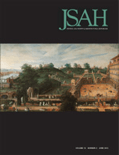
JOURNAL OF THE SOCIETY OF ARCHITECTURAL HISTORIANS
Championing Interdisciplinary Perspectives in ArchitectureJOURNAL OF THE SOCIETY OF ARCHITECTURAL HISTORIANS, published by the SOCIETY OF ARCHITECTURAL HISTORIANS, serves as a premier platform for the dissemination of scholarly research and critical discourse in the fields of architecture and architectural history. Established in 1970, this journal has undergone significant evolution, focusing on interdisciplinary studies that explore architectural heritage, theory, and practice. With a current impact factor that places it within the Q2 category in both History and Visual Arts and Performing Arts, as well as Q3 in Architecture, the journal maintains a robust reputation among academics and professionals alike. Although it operates under traditional access models, its essential role in fostering a deep understanding of architectural narratives and their socio-cultural contexts remains unparalleled. The journal also ranks favorably in Scopus, highlighting its importance in the arts and humanities, as well as engineering disciplines related to architecture. By bridging the gap between historical inquiry and contemporary architectural criticism, the JOURNAL OF THE SOCIETY OF ARCHITECTURAL HISTORIANS continues to be a vital resource for researchers, professionals, and students endeavoring to enrich their knowledge and contribute to this dynamic field.
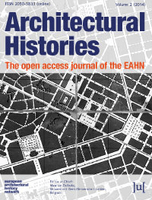
Architectural Histories
Illuminating the Intersection of Architecture and HistoryArchitectural Histories is a leading open-access journal published by UBIQUITY PRESS LTD since 2013, dedicated to the exploration and critique of architectural history. With an ISSN of 2050-5833 and an esteemed presence in the United Kingdom, the journal has gained notable recognition in various disciplines, achieving a Q2 ranking in Architecture, a Q1 ranking in History, and a Q1 ranking in Visual Arts and Performing Arts for 2023. It stands out with impressive Scopus ranks, placing it within the 79th percentile for Visual Arts and Performing Arts. The journal's scope emphasizes interdisciplinary approaches to architectural history, engaging researchers, professionals, and students alike in critical discourse. By providing a platform for innovative research and scholarly dialogue, Architectural Histories significantly contributes to the understanding of architecture's past and its implications for present and future practices, marking its importance in the academic community.

arq-Architectural Research Quarterly
Advancing Architectural Discourse Through Rigorous Researcharq-Architectural Research Quarterly, published by Cambridge University Press, is a leading journal in the fields of architecture, visual arts, and performing arts. With an ISSN of 1359-1355 and an E-ISSN of 1474-0516, the journal has successfully captured the essence of architectural research since its inception in 1995. Recognized for its rigorous academic contributions, it currently holds a Q4 quartile in Architecture and a Q3 quartile in Visual Arts and Performing Arts as of 2023, reflecting its commitment to advancing knowledge within these disciplines. While it does not offer Open Access, it remains a crucial resource for scholars, professionals, and students seeking to explore innovative ideas and practices in architecture and the arts. The journal features a diverse range of articles that foster interdisciplinary dialogue, making it an indispensable platform for those interested in shaping the future of architectural discourse.